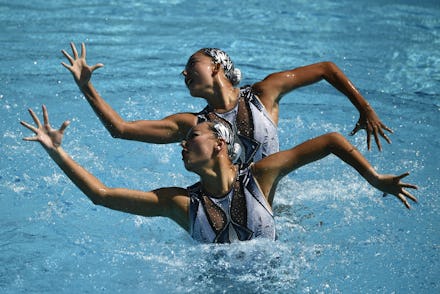Knoxing: the unexpected beauty hack that keeps Olympic swimmers' hair looking so good

Synchronized swimming is like water ballet — a cross between artful performance, athletic prowess and underwater survival. We may not know how these athletes hold their breath for so long, but now we know how they transform their hair into immaculate helmets: gelatin.
Yup, powdered gelatin — the active ingredient in Jell-O, Jell-O shots, panna cotta, soup dumplings and custards — is the secret to slicked-back hair that stays in place.
Swimmers call it Knoxing, after the most popular gelatin brand.
"When it dries, it gets really hard and your hair doesn't fall out when you swim," U.S. Olympic synchronized swimmers Anita Alvarez and Mariya Koroleva told Vogue. "We like to add glitter and other decorations to it — it's easy."
Why not just use hair gel or swim caps? Swim caps could fall off, and hair gel sometimes dissolves in water, Dale Mohammed, head coach of Gotham Synchro, a synchronized swim program in the NYC area, said in a phone interview. Mohammed picked up synchro in college and has been involved in the sport for roughly 30 years.
"It's an inexpensive, effective product that is widely available, and it works."
"Back in the '60s, synchronized swimmers tried a whole lot of different things like Dippity Do and Vaseline," Mohammed said. But once swimmers discovered gelatin, the idea stuck. "It's an inexpensive, effective product that is widely available, and it works," she said.
Here's how it works: Swimmers buy powdered Knox gelatin and mix it with hot water. Then they spread the paste-like mixture onto their hair.
That small amount is probably enough to cement fly-aways to the scalp for eternity. Still, some athletes go for a second coat, applied with a paintbrush.
Experienced gellers can "Knox" their hair in 10 to 15 minutes, Mohammed said. Beginners can take longer. "For those who aren't skilled, it can take a while to get smooth." It's routine for competition and exhibition. For example, check out this 2013 tweet from Mariya Koroleva, a current U.S. Olympic synchronized swimmer.
Some athletes opt to sleep with their hair done if they have a multi-day meet, to avoid redoing their hair. Can't blame them — that looks like an icky process. One Twitter user put it this way: "Knox'ing is like smearing cow spit mixed w rubber cement."
Getting the Knox out isn't an easy feat, either. Mohammed said the sticky stuff can be removed with hot water and conditioner, which loosens up the gelatin better than shampoo.
Luckily, Knoxing may have one benefit. Mohammed said that some people find it makes their hair softer to the touch after it's washed out. (Eating gelatin has certain health benefits like improved skin health, but applying it topically hasn't been shown to help your health in any way, Mohammed noted.)
Using gelatin as a hair product is also a sticky strategy used by people with mohawks. "Back in the '80s, the punk rockers would use our gelatin trick to hold their spikes in," Mohammed said. Mic was unable to verify whether it was punk rockers, synchro swimmers or another group entirely that pioneered using gelatin to slick hair up and down.